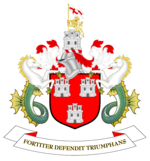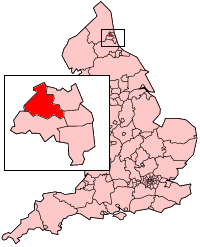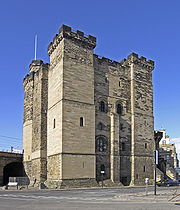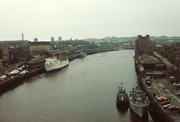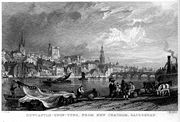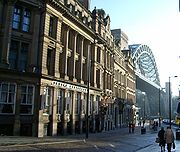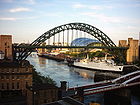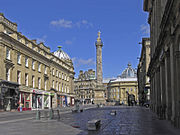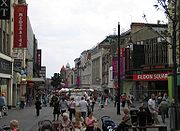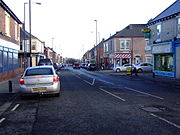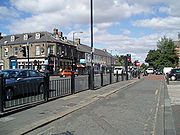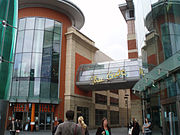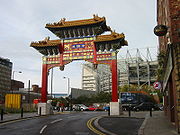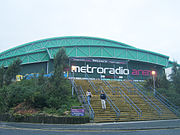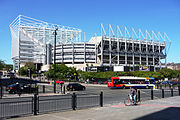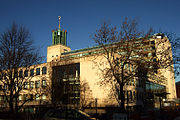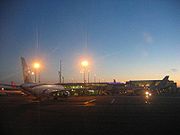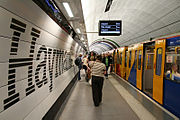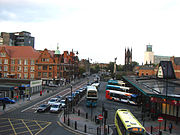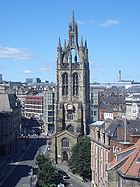
Newcastle upon Tyne
Background Information
SOS Children, an education charity, organised this selection. To compare sponsorship charities this is the best sponsorship link.
Coordinates: 54°58.440′N 1°36.792′W
| City of Newcastle upon Tyne Newcastle |
|||
|---|---|---|---|
| — Metropolitan borough & City — | |||
| Newcastle city centre & River Tyne viewed from Gateshead | |||
|
|||
| Nickname(s): The Toon | |||
| Motto: "Fortiter Defendit Triumphans" "Triumphing by brave defence" | |||
| Newcastle upon Tyne shown within England | |||
| Coordinates: 54°58′N 1°36′W | |||
| Sovereign state | United Kingdom | ||
| Constituent country | England | ||
| Region | North East England | ||
| Ceremonial county | Tyne and Wear | ||
| Admin HQ | Newcastle City Centre | ||
| Founded | 2nd century | ||
| Town charter | Henry II | ||
| County Corporate | 1400 | ||
| Government | |||
| • Type | Metropolitan borough, City | ||
| • Governing body | Newcastle City Council | ||
| • Lord Mayor | Councillor Michael Cookson | ||
| Area | |||
| • Metropolitan borough & City | 44 sq mi (113 km2) | ||
| Population (2011 est.) | |||
| • Metropolitan borough & City | 279,100 ([[List of English districts by population|Ranked 38th]]) | ||
| • Metro | 879,996 ( Tyneside) | ||
| Time zone | Greenwich Mean Time ( UTC+0) | ||
| Postcode | NE | ||
| Area code(s) | 0191 | ||
| Ethnicity ( 2006 Estimates) |
|||
| ISO 3166-2 | GB-NET | ||
| ONS code | 00CJ | ||
| OS grid reference | NZ249645 | ||
| NUTS 3 | UKC22 | ||
| Demonym | Geordie, Novocastrian | ||
| Website | www.newcastle.gov.uk | ||
Newcastle upon Tyne (locally / n juː ˈ k æ s əl /) (often shortened to Newcastle) is a city and metropolitan borough of Tyne and Wear, in North East England. Situated on the north bank of the River Tyne, the city developed in the area that was the location of the Roman settlement called Pons Aelius, though it owes its name to the castle built in 1080, by Robert II, Duke of Normandy, the eldest son of William the Conqueror. The city grew as an important centre for the wool trade and it later became a major coal mining area. The port developed in the 16th century and, along with the shipyards lower down the river, was amongst the world's largest shipbuilding and ship-repairing centres. These industries have since experienced severe decline and closure, and the city today is largely a business and cultural centre, with a particular reputation for nightlife.
Newcastle is the 8th most visited city in the United Kingdom and is the 122nd most visited city in the world.
Like most cities, Newcastle has a diverse cross section, from areas of poverty to areas of affluence. Among its main icons are Newcastle Brown Ale, a leading brand of beer, Newcastle United F.C., a Premier League team, and the Tyne Bridge. It has hosted the world's most popular half marathon, the Great North Run, since it began in 1981.
The city is the twentieth most populous urban area in England; the larger Tyneside conurbation, of which Newcastle forms part, is the sixth most populous conurbation in the United Kingdom. Newcastle is a member of the English Core Cities Group and with Gateshead the Eurocities network of European cities.
The regional nickname for people from Newcastle and the surrounding area is Geordie.
History
Roman
The first settlement in what is now Newcastle was Pons Aelius, a Roman fort and bridge across the River Tyne and given the family name of the Roman Emperor Hadrian who founded it in the 2nd century AD. The population of Pons Aelius at this period was estimated at 2,000. Hadrian's Wall is still visible in parts of Newcastle, particularly along the West Road. The course of the "Roman Wall" can also be traced eastwards to the Segedunum Roman fort in Wallsend—the wall's end and to the supply fort Arbeia in South Shields. The extent of Hadrian's Wall was 73 miles (117 km), spanning the width of Britain; the wall incorporated Agricola's Ditch and was constructed primarily to prevent unwanted immigration and incursion of Pictish tribes from the north, not as a fighting line for a major invasion.
Anglo-Saxon and Norman
After the Roman departure from Britain, completed in 410, Newcastle became part of the powerful Anglo-Saxon kingdom of Northumbria, and became known throughout this period as Monkchester. After a series of conflicts with the Danes and the devastation north of the River Tyne inflicted by Odo of Bayeux after the 1080 rebellion against the Normans, Monkchester was all but destroyed. Because of its strategic position, Robert Curthose, son of William the Conqueror, erected a wooden castle there in the year 1080 and the town was henceforth known as Novum Castellum or New Castle.
Middle Ages
Throughout the Middle Ages, Newcastle was England's northern fortress. Incorporated first by Henry II, a new charter was granted by Elizabeth in 1589. A 25-foot (7.6 m) high stone wall was built around the town in the 13th century, to defend it from invaders during the Border war against Scotland. The Scots king William the Lion was imprisoned in Newcastle in 1174, and Edward I brought the Stone of Scone and William Wallace south through the town. Newcastle was successfully defended against the Scots three times during the 14th century, and was created a county corporate with its own sheriff by Henry IV in 1400.
16th to 19th century
From 1530 a royal act restricted all shipments of coal from Tyneside to Newcastle Quayside, giving a monopoly in the coal trade to a cartel of Newcastle burgesses known as the Hostmen. This monopoly, which lasted for a considerable time, helped Newcastle prosper, but it had its impact on the growth of near-neighbours Sunderland, causing a Tyneside and a Wearside rivalry that still exists. In the Sandgate area, to the east of the city and beside the river, resided the close-knit community of keelmen and their families. They were so called because they worked on the keels, boats that were used to transfer coal from the river banks to the waiting colliers, for export to London and elsewhere. In 1636 about 7,000 out of 20,000 inhabitants of Newcastle died of plague.
During the English Civil War, Newcastle supported the king and in 1644 the city was besieged for many months, then stormed ('with roaring drummes') and sacked by Cromwell's Scots allies, based in pro-Parliament Sunderland. The grateful King bestowed the motto "Fortiter Defendit Triumphans" ("Triumphing by a brave defence") upon the town. Ironically, Charles was imprisoned in Newcastle by the Scots in 1646-7.
In the 18th century, Newcastle was the country's fourth largest print centre after London, Oxford and Cambridge, and the Literary and Philosophical Society of 1793, with its erudite debates and large stock of books in several languages, predated the London Library by half a century. Newcastle also became a glass producer with a reputation for brilliant flint glass.
Newcastle's development as a major city, however, owed most to its central role in the export of coal. The phrase taking coals to Newcastle was first recorded in 1538. In the 19th century, shipbuilding and heavy engineering were central to the city's prosperity; and the city was a powerhouse of the Industrial Revolution. Innovation in Newcastle and surrounding areas included the development of safety lamps, Stephenson's Rocket, Lord Armstrong's artillery, Be-Ro flour, Joseph Swan's electric light bulbs, and Charles Parsons' invention of the steam turbine, which led to the revolution of marine propulsion and the production of cheap electricity.
Geography
Newcastle is situated in the North East of England, in the ceremonial county of Tyne and Wear and the historical and traditional county of Northumberland. The city is located on the northern bank of the River Tyne at a latitude of 54.974° N and a longitude of 1.614° W.
The ground beneath the city is formed from Carboniferous strata of the Middle Pennine Coal Measures Group—a suite of sandstones, mudstones and coal seams which generally dip moderately eastwards. To the west of the city are the Upper Pennine Coal Measures and further west again the sandstones and mudstones of the Stainmore Formation, the local equivalent of the Millstone Grit.
In large parts, Newcastle still retains a medieval street layout. Narrow alleys or ' chares', most of which can only be traversed by foot, still exist in abundance, particularly around the riverside. Stairs from the riverside to higher parts of the city centre and the extant Castle Keep, originally recorded in the 14th century, remain in places. Close, Sandhill and Quayside contain modern buildings as well as structures dating from the 15th–18th centuries, including Bessie Surtees House, the Cooperage and Lloyds Quayside Bars, Derwentwater House and the currently unused Grade I-listed 16th century merchant's house at 28–30 Close.
The city has an extensive neoclassical centre referred to as Tyneside Classical largely developed in the 1830s by Richard Grainger and John Dobson, and recently extensively restored. Broadcaster and writer Stuart Maconie described Newcastle as England's best-looking city and the late German-born British scholar of architecture, Sir Nikolaus Bernhard Leon Pevsner, describes Grey Street as one of the finest streets in England, and Grey Street, which curves down from Grey's Monument towards the valley of the River Tyne, was voted as England's finest street in 2005 in a survey of BBC Radio 4 listeners. In the Google Street View awards of 2010, Grey Street came 3rd in the British picturesque category. Osborne Road came 4th in the foodie street category. A portion of Grainger Town was demolished in the 1960s to make way for the Eldon Square Shopping Centre, including all but one side of the original Eldon Square itself.
Immediately to the northwest of the city centre is Leazes Park, established in 1873 after a petition by 3,000 working men of the city for "ready access to some open ground for the purpose of health and recreation". Just outside one corner of this is St James' Park, the stadium home of Newcastle United F.C. which dominates the view of the city from all directions.
Another green space in Newcastle is the Town Moor, lying immediately north of the city centre. It is larger than Hyde Park and Hampstead Heath put together and the freemen of the city have the right to graze cattle on it. Unlike other cities where similar rights exist, they often take advantage of this. The right incidentally extends to the pitch of St. James' Park, Newcastle United Football Club's ground, though this is not exercised, although the Freemen do collect rent for the loss of privilege. Honorary freemen include Bob Geldof, King Harald V of Norway, Nelson Mandela, Bobby Robson, Alan Shearer and the Royal Shakespeare Company. The The Hoppings funfair, said to be the largest travelling fair in Europe, is held here annually in June.
In the south eastern corner is Exhibition Park, which contains the only remaining pavilion from the North East Coast Exhibition of 1929. Since the 1970s this has housed the Newcastle Military Vehicle Museum; this is closed until further notice because of structural problems with the building—originally a temporary structure.
The wooded gorge of the Ouseburn in the east of the city is known as Jesmond Dene and forms another popular recreation area, linked by Armstrong Park and Heaton Park to the Ouseburn Valley, where the river finally reaches the River Tyne.
Notable Newcastle housing developments include Ralph Erskine's the Byker Wall designed in the 1960s and now Grade II* listed. It is on UNESCO's list of outstanding 20th century buildings.
Newcastle's thriving Chinatown lies in the north-west of Grainger Town, centred on Stowell Street. A new Chinese arch, or paifang, providing a landmark entrance, was handed over to the city with a ceremony in 2005.
The UK's first biotechnology village, the " Centre for Life" is located in the city centre close to the Central Station. The village is the first step in the City Council's plans to transform Newcastle into a science city.
Newcastle was voted as the Best City in the North in April 2007 by The Daily Telegraph newspaper—beating Liverpool, Manchester, Sheffield and Leeds in an online poll conducted of its readers.
Quayside and bridges on the Tyne
The Tyne Gorge, between Newcastle on the north bank and Gateshead—a separate town and borough—on the south bank, is famous for a series of dramatic bridges, including the Tyne Bridge of 1928 which was built by Dorman Long of Middlesbrough, and Robert Stephenson's High Level Bridge of 1849, the first road/rail bridge in the world.
Large-scale regeneration has replaced former shipping premises with imposing new office developments; an innovative tilting bridge, the Gateshead Millennium Bridge was commissioned by Gateshead Council and has integrated the older Newcastle Quayside more closely with major cultural developments in Gateshead, including the BALTIC Centre for Contemporary Art, the venue for the Turner Prize 2011 and the Norman Foster-designed The Sage Gateshead music centre. The Newcastle and Gateshead Quaysides are now a thriving, cosmopolitan area with bars, restaurants and public spaces. As a tourist promotion, Newcastle and Gateshead have linked together under the banner " NewcastleGateshead", to spearhead the regeneration of the North-East. The River Tyne had the temporary Bambuco Bridge in 2008 for ten days; it was not made for walking, road or cycling, but was just a sculpture.
Grainger Town
The historic heart of Newcastle is the Grainger Town area. Established on classical streets built by Richard Grainger, a builder and developer, between 1835 and 1842, some of Newcastle upon Tyne's finest buildings and streets lie within this area of the city centre including Grainger Market, Theatre Royal, Grey Street, Grainger Street and Clayton Street. These buildings are predominately four storeys, with vertical dormers, domes, turrets and spikes. Richard Grainger was said to 'have found Newcastle of bricks and timber and left it in stone'. Of Grainger Towns 450 buildings, 244 are listed, of which 29 are grade I and 49 are grade II*.
Grey's Monument which stands beside Monument Metro Station, was designed and built by Edward Hodges Baily and Benjamin Green. Hodges, who also built the Nelson's Column, designed and built the statue, and the monument plinth was designed and built by Benjamin Green.
The development of the city in the 1960s and 1970s saw the demolition of part of Grainger Town as a prelude to the modernist rebuilding initiatives of T. Dan Smith, the leader of Newcastle City Council. A corruption scandal was uncovered involving Smith and John Poulson, a property developer from Pontefract, West Yorkshire, and both were imprisoned. Echoes of the scandal were revisited in the late 1990s in the BBC TV mini-series, Our Friends in the North.
Climate
The climate in Newcastle is oceanic ( Köppen Cfb) and significantly warmer than some other locations in the world at a similar latitude, due to the warming influence of the Gulf Stream (via the North Atlantic Drift). Being in the rain shadow of the North Pennines, it is among the driest cities in the UK.
| Climate data for Newcastle (Met Office Durham) | |||||||||||||
|---|---|---|---|---|---|---|---|---|---|---|---|---|---|
| Month | Jan | Feb | Mar | Apr | May | Jun | Jul | Aug | Sep | Oct | Nov | Dec | Year |
| Average high °C (°F) | 6.6 (43.9) |
7.2 (45) |
9.5 (49.1) |
11.9 (53.4) |
15 (59) |
17.6 (63.7) |
20.1 (68.2) |
19.8 (67.6) |
17.2 (63) |
13.3 (55.9) |
9.4 (48.9) |
6.7 (44.1) |
12.9 (55.2) |
| Average low °C (°F) | 0.9 (33.6) |
0.9 (33.6) |
2.3 (36.1) |
3.7 (38.7) |
6.1 (43) |
9 (48.2) |
11.1 (52) |
11 (51.8) |
9 (48.2) |
6.3 (43.3) |
3.4 (38.1) |
1.1 (34) |
5.4 (41.7) |
| Precipitation mm (inches) | 52.3 (2.059) |
41.8 (1.646) |
44.6 (1.756) |
52.7 (2.075) |
44.2 (1.74) |
55.4 (2.181) |
54 (2.13) |
60.8 (2.394) |
55.4 (2.181) |
60.9 (2.398) |
72 (2.83) |
57 (2.24) |
651.1 (25.634) |
| Avg. rainy days (≥ 1.0 mm) | 11.4 | 9.3 | 9.7 | 9.5 | 9.2 | 9.7 | 9 | 9.6 | 9.3 | 11.3 | 12.3 | 11.7 | 122 |
| Mean monthly sunshine hours | 58.6 | 80.3 | 115.5 | 150.3 | 181.7 | 164.8 | 172.3 | 167.3 | 134.5 | 102.8 | 66.4 | 51.2 | 1445.4 |
| Source: Met Office | |||||||||||||
Economy
Newcastle played a major role during the 19th-century Industrial Revolution, and was a leading centre for coal mining and manufacturing. Heavy industries in Newcastle declined in the second half of the 20th century; office, service and retail employment are now the city's staples. The city is also today recognised for its commitment to environmental issues, with a programme planned for Newcastle to become "the first Carbon Neutral town".
Newcastle is the commercial, educational and, in partnership with nearby Gateshead, the cultural focus for North East England. As part of Tyneside, Newcastle's economy contributes around £13 billion to the UK GVA. The Central Business District is in the centre of the city, bounded by Haymarket, Central Station and the Quayside areas.
Retail
There are several major shopping areas in Newcastle city centre. The largest of these is the Eldon Square Shopping Centre, currently the largest city centre shopping complex in the UK. It incorporates the first and largest Fenwick department store, one of the largest Marks and Spencer stores outside London, a flagship Debenhams store as well as one of the largest John Lewis stores, still known to many in Newcastle as Bainbridges. This store was possibly "...one of the earliest of all department stores". Eldon Square is currently undergoing a full redevelopment. A new bus station, replacing the old underground bus station, was officially opened in March 2007. The wing of the centre, including the undercover Green Market, near Grainger Street and The Gate was demolished in 2007 so that the area could be redeveloped. This was completed in February 2010 with the opening of a flagship Debenhams department store as well as other major stores including Apple, Hollister & Guess
The main shopping street in the city is Northumberland Street. In a 2004 report, it was ranked as the most expensive shopping street in the UK for rent, outside of London. Other shopping destinations in Newcastle include Grainger Street and the area around Grey's Monument, the relatively modern Eldon Garden and Monument Mall complexes, the Newgate Centre, Central Arcade and the traditional Grainger Market. Outside the city centre, the largest suburban shopping areas are Gosforth and Byker. The largest Tesco store in the United Kingdom is located in Kingston Park on the edge of Newcastle. Close to Newcastle, the largest indoor shopping centre in Europe, the MetroCentre, is located in Gateshead.
Demography
Population
According to the UK Government's 2001 census, the city of Newcastle has a population of 189,863, whereas the unitary authority of Newcastle has a population of around 259,500. However, the metropolitan boroughs of North Tyneside (population c.190,000), South Tyneside (population c. 150,000) and Gateshead (population c.200,000) are also part of the Tyneside conurbation, giving the Newcastle-Gateshead metropolitan area a population of 799,000. According to the same statistics, the average age of people living in Newcastle is 37.8 (the national average being 38.6). 93.1% of the population are of white British ethnic background (the national average being 91.3%). Many people in the city have Scottish or Irish ancestors. There is a strong presence of Border Reiver surnames, such as Armstrong, Charlton, Elliot, Johnstone, Kerr, Hall, Nixon, Little and Robson. Other ethnic groups in Newcastle, in order of population size, are Pakistani at 1.9% and Indians at 1.2%. There are also small but significant Chinese, Jewish and Eastern European (Polish, Czech Roma) populations. There are also estimated to be between 500 and 2,000 Bolivians in Newcastle, forming up to 1% of the population—the largest such percentage of any UK city.
The city is largely Christian at 70.6%; Muslims form 3.6%, and over 16% have no religion.
According to 2008 figures, the city's ethnic make-up is as follows:
- White – 90.5%
- South Asian – 5.2%
- Black – 1.1%
- Chinese – 1.1%
- Mixed-race – 1.2%
- Other – 0.8%
The regional nickname for people from Newcastle and the surrounding area is Geordie. The Latin term Novocastrian, which can equally be applied to residents of any place called Newcastle, is also used for ex-pupils of the city's Royal Grammar School.
Year and current total population
- 1801 – 33,322
- 1851 – 80,184
- 1901 – 246,905
- 1911 – 293,944
- 1921 – 309,820
- 1931 – 326,576
- 1941 – 333,286
- 1951 – 340,155
- 1961 – 323,844
- 1971 – 308,317
- 1981 – 272,923
- 1991 – 277,723
- 2001 – 259,573
- 2007 – 271,600
- 2008 – 273,600
Dialect
The dialect of Newcastle is known as Geordie, and contains a large amount of vocabulary and distinctive word pronunciations not used in other parts of the United Kingdom. The Geordie dialect has much of its origins in the language spoken by Anglo-Saxon mercenaries, who were employed by the Ancient British people to fight Pictish invaders, following the withdrawal of the Romans from Britain in the 4th century. This language was the forerunner of Modern English; but while the dialects of other English regions have been heavily altered by the influences of other foreign languages—particularly Latin and Norman French—the Geordie dialect retains many elements of the old language. An example of this is the pronunciation of certain words: "dead", "cow", "house" and "strong" are pronounced "dede", "coo", "hoos" and "strang"—which is how they were pronounced in the Anglo-Saxon language. Other Geordie words with Anglo-Saxon origins include: "larn" (from the Anglo-Saxon "laeran", meaning "teach"), "burn" ("stream") and "gan" ("go"). "Bairn" and "hyem", meaning "child" and "home", are examples of Geordie words with origins in Scandinavia; "barn" and "hjem" are the corresponding modern Norwegian words. Some words used in the Geordie dialect are used elsewhere in the northern United Kingdom. The words "bonny" (meaning "pretty"), "howay" ("come on"), "stot" ("bounce") and "hadaway" ("go away" or "you're kidding"), all appear to be used in Scottish dialect; "aye" ("yes") and "nowt" (IPA://naʊt/, rhymes with out,"nothing") are used elsewhere in northern England. Many words, however, appear to be used exclusively in Newcastle and the surrounding area, such as "Canny" (a versatile word meaning "good", "nice" or "very"), "bait" ("food"), "hacky" ("dirty"), "netty" ("toilet"), "hoy" ("throw"), "hockle" ("spit").
Health
Newcastle Hospitals NHS Foundation Trust has one of the lowest mortality rates in the country and is ranked seventh in the country for confidence in doctors. Newcastle has three large teaching hospitals: the Royal Victoria Infirmary, the Newcastle General Hospital and the Freeman Hospital, which is also a pioneering centre for transplant surgery.
In a report, published in early February 2007 by the Ear Institute at the University College London, and Widex, a Danish hearing aid manufacturer, Newcastle was named as the noisiest city in the whole of the UK, with an average level of 80.4 decibels. The report claimed that these noise levels would have a negative long-term impact on the health of the city's residents. The report was criticised, however, for attaching too much weight to readings at arbitrarily selected locations, which in Newcastle's case included a motorway underpass without pedestrian access.
Culture
Nightlife
Newcastle was in the top ten of the country's top night spots, and The Rough Guide to Britain placed Newcastle upon Tyne's nightlife as Great Britain's no. 1 tourist attraction. In the Tripadvisor Travellers’ Choice Destination Awards for European Nightlife destinations, four of the UK's nightspots finished in the top 10; Newcastle was awarded 3rd Place behind London, and Berlin. Newcastle also came in seventh for the World category.
There are notable concentrations of pubs, bars and nightclubs around the Bigg Market, and the Quayside area of the city centre. There are many bars on the Bigg Market, and other popular areas for nightlife are Collingwood Street, Neville Street, the Central Station area and Osborne Road in the Jesmond area of the city. In recent years " The Gate" has opened in the city centre, a new indoor complex consisting of bars, upmarket clubs, restaurants and a 12-screen Empire multiplex cinema. Newcastle's gay scene is centred around the Times Square area near the Centre for Life and has a range of bars, cafés and clubs.
The city has a wide variety of restaurants such as Italian, Indian, Persian, Japanese, Greek, Mexican, Spanish, American, Polish, Malaysian, French, Mongolian, Moroccan, Thai food, Vietnamese, Lebanese, and has a Chinese village with many Chinese restaurants on Stowell Street. There has also been a growth in premium restaurants in recent years with top chefs.
Theatre
The city has a proud history of theatre. Stephen Kemble of the famous Kemble family successfully managed the original Theatre Royal, Newcastle for fifteen years (1791–1806). He brought members of his famous acting family such as Sarah Siddons and John Kemble out of London to Newcastle. Stephen Kemble guided the Theatre through many celebrated seasons. The original Theatre Royal was opened on 21 January 1788 and was located on Mosley Street, next to Drury Lane.
The city still contains many theatres. The largest, the Theatre Royal on Grey Street, first opened in 1837, designed by John and Benjamin Green. It has hosted a season of performances from the Royal Shakespeare Company for over 25 years, as well as touring productions of West End musicals. The Journal Tyne Theatre hosts smaller touring productions, whilst other venues feature local talent. Northern Stage, formally known as the Newcastle Playhouse and Gulbenkian Studio, hosts various local, national and international productions in addition to those produced by the Northern Stage company. Other theatres in the city include the Live Theatre, the People's Theatre, the Round and the Jubilee Theatre. NewcastleGateshead was voted in 2006 as the arts capital of the UK in a survey conducted by the Artsworld TV channel.
Poetry
Newcastle has a strong reputation as a poetry centre. The Morden Tower, run by poet Tom Pickard is a major venue for poetry readings in the North East, being the place where Basil Bunting gave the first reading of Briggflatts in 1965.
Festivals and fairs
In February, Newcastle's Chinatown is at the centre of a carnival of colour and noise as the city celebrates the Chinese New Year. In early March there is the NewcastleGateshead Comedy Festival, this event makes a return to the region since the last event in 2006, it is hoped it will now continue as an annual event. The Newcastle Science Festival, now called Newcastle ScienceFest returns annually in early March.
The Newcastle Beer Festival, organised by CAMRA, takes place in April. In May, Newcastle and Gateshead host the Evolution Festival, a music festival held on the Newcastle and Gateshead Quaysides over the Spring bank holiday, with performances by acts from the world of Rock, Indie and Dance music. The biennial AV Festival of international electronic art, featuring exhibitions, concerts, conferences and film screenings, is held in March. The North East Art Expo, a festival of art and design from the regions professional artists, is held in late May. EAT! NewcastleGateshead, a festival of food and drink, runs for 2 weeks each year in mid June.
The Hoppings, reputedly the largest travelling fair in Europe, takes place on Newcastle Town Moor every June. The event has its origins in the Temperance Movement during the early 1880s and coincides with the annual race week at High Gosforth Park. Newcastle Community Green Festival, which claims to be the UK's biggest free community environmental festival, also takes place every June, in Leazes Park. The Northern Rock Cyclone, a cycling festival, takes place within, or starting from, Newcastle in June. The 'Northern Gay Pride' Festival and Parade is held in Leazes Park and in the city's 'Gay Community' in mid July. The Ouseburn Festival, a family oriented weekend festival near the city centre, incorporating a "Family Fun Day" and "Carnival Day", is held in late July.
Newcastle Mela, held on the late August bank holiday weekend, is an annual two-day multicultural event, blending drama, music and food from Punjabi, Pakistani, Bengali and Hindu cultures. NewcastleGateshead also holds an annual International Arts Fair. The 2009 event will be in the Norman Foster designed Sage Gateshead Music and Arts Centre in September. In October, there is the Design Event festival—an annual festival providing the public with an opportunity to see work by regional, national and international designers. The SAMA Festival, an East Asian cultural festival is also held in early October.
Music
The 1960s saw the internationally successful rock group The Animals, emerge from Newcastle night spots such as Club A-Go-Go on Percy Street. Other well-known acts with connections to the city include Sting, Bryan Ferry, Dire Straits and more recently Maxïmo Park.
There is also a thriving underground music scene that encompasses a variety of styles, including Drum and Bass, doom metal and Post-rock.
Lindisfarne are a folk-rock group with a strong Tyneside connection. Their most famous song, " Fog on the Tyne" (1971), was covered by Geordie ex-footballer Paul Gascoigne in 1990. Venom, reckoned by many to be the originators of black metal and extremely influential to the extreme metal scene as a whole, formed in Newcastle in 1979. Folk metal band Skyclad, often regarded as the first folk metal band, also formed in Newcastle after the breakup of Martin Walkyier thrash metal band, Sabbat.
Newcastle is the home of Kitchenware Records (circa 1982), previously home to acclaimed bands such as Prefab Sprout, Martin Stephenson and the Daintees and Fatima Mansions, the management of The Lighthouse Family and home to recent successes Editors as well as other bands of varied genres.
The 1990s boom in progressive house music saw the city's Global Underground record label publish mix CDs by the likes of Sasha, Paul Oakenfold, James Lavelle, and Danny Howells recording mix compilations. The label is still going strong today with offices in London and New York, and new releases from Deep Dish and Adam Freeland.
Concert venues
The largest music venue in the city is the 11,000-seat Metro Radio Arena, which is situated in the south of the city centre near the Centre for Life. The 2,000-seat Newcastle City Hall holds a number of music events every month, particularly featuring solo artists. Both of the city's universities also have large performance venues (each holding around 2,000 people).
On 14 October 2005, the 2,000 capacity O2 Academy Newcastle opened, providing a new music venue in the city centre. The opening night was headlined by The Futureheads and the profile of the venue has attracted a greater variety of bands to play in the city. The O2 Academy Newcastle is one in a string of Academies to be opened across the UK.
Other popular music venues in the city include The Head of Steam, which is near Newcastle Central railway station, and Trillians Rock Bar at Princess Square. The Cluny and the Cumberland Arms are both situated in the Ouseburn Valley between the city centre and Byker.
Cinema
Aside from the city centre chain-cinema, the Empire multiplex, the city has its own independent cinema, the Tyneside Cinema. The Tyneside Cinema on Pilgrim Street originally opened as the 'Bijou News-Reel Cinema' in 1937, and was designed and built by Dixon Scott, great uncle of film director Ridley Scott.
In May 2008 the Tyneside Cinema reopened in the restored and refurbished original building. The site currently houses three cinemas, including the restored Classic—the United Kingdom's last surviving news cinema still in full-time operation—alongside two new screens, a roof extension containing the Tyneside Bar, and dedicated education and teaching suites.
Museums and galleries
There are several museums and galleries in Newcastle, including the Centre for Life, Discovery Museum, the Great North Museum, Gallagher & Turner Gallery, the Laing Art Gallery, The Biscuit Factory (a commercial gallery) and the Newburn Hall Motor Museum.
In film
The earliest known movie featuring some exterior scenes filmed in the city is On the Night of the Fire (1939), though by and large the action is studio-bound. Later came The Clouded Yellow (1951) and Payroll (1961), both of which feature more extensive scenes filmed in the city. The 1971 film Get Carter was shot on location in and around Newcastle and offers an opportunity to see what Newcastle looked like in the 1960s and early 1970s. The city was also backdrop to another gangster film, the 1988 film noir thriller Stormy Monday, directed by Mike Figgis and starring Tommy Lee Jones, Melanie Griffith, Sting and Sean Bean.
More recently the city has been the setting for films based around football; films such as Purely Belter, The One and Only and Goal! have all been focused around Tyneside. The comedy School for Seduction starring Kelly Brook was also filmed in Newcastle.
The Bollywood film Hum Tum Aur Ghost was shot on location in Newcastle's city centre and features key scenes in and around Grainger Town.
Sport
The city has a strong sporting tradition. Football club Newcastle United has been based at St James' Park since the club was established in 1892, although any traces of the original structure are now long gone as the stadium now holds more than 52,000 seated spectators. The city also has a non-League football club, Newcastle Benfield. Also based in Newcastle are Guinness Premiership rugby union side Newcastle Falcons and 1996 Pilkington Shield winners Medicals RFC.
The Metro Radio Arena is home to Newcastle Vipers ice hockey team and Newcastle Eagles basketball team. The city's speedway team Newcastle Diamonds are based at Brough Park in Byker, a venue that is also home to greyhound racing. Newcastle also hosts the start of the annual Great North Run, the world's largest half-marathon in which participants race over the Tyne Bridge into Gateshead and then towards the finish line 13.1 miles (21.1 km) away on the coast at South Shields. Another famous athletic event is the 5.9-mile (9.5 km) Blaydon Race (a road race from Newcastle to Blaydon), which has taken place on 9 June annually since 1981, to commemorate the celebrated Blaydon Races horse racing.
Government
Newcastle is governed using the leader and cabinet system, and the executive is Liberal Democrat, as they have 42 councillors against the Labour Party's 34. No other parties hold seats on the city's council, however there are 2 independent Councillors.
For the purposes of City Council elections, Newcastle is divided into 26 electoral wards.
|
|
Transport
Airport
Newcastle International Airport is located approximately 6 miles (9.7 km) from the city centre on the northern outskirts of the city near Ponteland and is the largest of the two main airports serving the North East. It is connected to the city via the Metro Light Rail system and a jourrney into Newcastle City Centre takes approximately 20 minutes. The airport handles over five million passengers per year, and is the tenth largest, and the fastest growing regional airport in the UK, expecting to reach 10 million passengers by 2016, and 15 million by 2030. As of 2007, over 90 destinations are available worldwide.
Rail
Newcastle railway station, also known as Newcastle Central Station, is a principal stop on the East Coast Main Line and Cross Country Route. Opened in 1850 by Queen Victoria, it was the first covered railway station in the world and was much copied across the UK. It has a neoclassical facade, originally designed by the architect John Dobson, and was constructed in collaboration with Robert Stephenson. The first services were operated by the North Eastern Railway company. The city's other mainline station, Manors, is to the east of the city centre.
Train operator East Coast provides a half-hourly frequency of trains to London King's Cross, with a journey time of about three hours. CrossCountry and First TransPennine Express operate regular services to many major destinations, whereas Northern Rail provides local and regional services.
Metro
The city is served by the Tyne and Wear Metro, a system of suburban and underground railways covering a lot of Tyne and Wear. It was opened in five phases between 1980 and 1984, and was Britain's first urban light rail transit system; two extensions were opened in 1991 and 2002. It was developed from a combination of existing and newly built tracks and stations, with deep-level tunnels constructed through Newcastle city centre. A bridge was built across the Tyne, between Newcastle and Gateshead, and opened by Queen Elizabeth II in 1981. The network is operated by Nexus and carries over 37 million passengers a year, extending as far as Newcastle Airport, Tynemouth, South Shields and South Hylton in Sunderland. The Metro system is the first in the UK to have mobile phone antennae installed in the tunnels.
The Metro consists of two lines. The Green line starts at Newcastle Airport, goes through the city centre and into Sunderland, terminating at South Hylton. The yellow line starts at St. James Park, runs north of the river alongside Byker towards Whitley Bay, before returning to the city, on to Gateshead and terminates at South Shields.
Road
Major roads in the area include the A1 (Gateshead Newcastle Western Bypass), stretching north to Edinburgh and south to London; the A19 heading south past Sunderland and Middlesbrough to York and Doncaster; the A69 heading west to Carlisle; the A167, the old "Great North Road", heading south to Gateshead, Chester-le-Street, Durham and Darlington; and the A1058 "Coast Road", which runs from Jesmond to the east coast between Tynemouth and Cullercoats. Many of these designations are recent—upon completion of the Western Bypass, and its designation as the new line of the A1, the roads between this and the A1's former alignment through the Tyne Tunnel were renumbered, with many city centre roads changing from a 6-prefix to their present 1-prefix numbers.
Bus
There are 3 main bus companies providing services in the city; Arriva North East, Go North East and Stagecoach North East. Arriva services mainly operate from Haymarket Bus Station going mostly to Northumberland but also parts of North Tyneside. Go-Ahead operates mainly from Eldon Square Bus Station and Grainger Town going mostly to places south of the river such as South Tyneside, Gateshead, MetroCentre, Sunderland, and County Durham, but also operating north of the river in North Tyneside. Stagecoach is the main operator in the city proper, providing services mainly between both the West and East ends via the city centre, and also going from the city to nearby places outside of the city itself such as Wallsend to the east of Newcastle and Killingworth to the north east (although Go North East mostly operates in these areas). Bus Services in Newcastle upon Tyne and the surrounding boroughs part of the Tyne and Wear area are coordinated by Nexus, the Tyne and Wear Passenger Transport Executive. Other major departure points are Pilgrim Street for buses running South of the Tyne via Gateshead, and Blackett Street/Monument for services to the East or West of the city. Many bus services also pass Newcastle Central Station, a major interchange for Rail and Metro Services. QuayLink is a bus service operated to the Quayside from Newcastle and Gateshead. Newcastle Coach Station, near the railway station, handles long distance bus services operated by National Express.
Cycle
Newcastle is accessible by several mostly traffic-free cycle routes that lead to the edges of the city centre, where cyclists can continue into the city by road, using no car lanes. The traffic-free C2C cycle route runs along the north bank of the River Tyne, enabling cyclists to travel off-road to North Shields and Tynemouth in the east, and westwards towards Hexham.
Suburban cycle routes exist, which utilise converted trackbeds of former industrial wagonways and industrial railways. A network of signed on-road cycle routes is being established, including some designated on-road cycle lanes that will lead from the city centre to the suburbs of Gosforth, Heaton and Wallsend.
Water
Newcastle has access to an international Ferry Terminal, at North Shields, which offers services to destinations including IJmuiden (near Amsterdam). A ferry to Gothenburg, Sweden, operated by Danish DFDS Seaways, ceased crossing at the end of October 2006. The company cited high fuel prices and new competition from low-cost air services as the cause. Another ferry service to Bergen and Stavanger, Norway was terminated late 2008. From summer 2007, Thomson cruise lines includes Newcastle as a port of call on its Norwegian and Fjords cruise.
Education
The city has two universities— Newcastle University and Northumbria University. Established as a School of Medicine and Surgery in 1834, and becoming independent from Durham University in 1963, Newcastle University is now one of the UK's leading international universities. It won the coveted Sunday Times University of the Year award in 2000. Newcastle Polytechnic was granted university status in 1992, becoming the University of Northumbria at Newcastle. Northumbria University, as it is currently known, was voted 'Best New University' by The Times Good University Guide 2005. The latter university also won a much coveted company award of the "Most IT enabled organisation" (in the UK), by the IT industry magazine Computing.
There are eleven LEA-funded 11 to 18 schools and seven independent schools with sixth forms in Newcastle. There are a number of successful state schools, including Walker Technology College, Gosforth High School, Heaton Manor School, St Cuthbert's High School, St. Mary's Catholic Comprehensive School, Kenton Comprehensive School, George Stephenson High School and Sacred Heart. The largest co-ed independent school is the Royal Grammar School. The largest girls' independent school is Central Newcastle High School. Both schools are located on the same street in Jesmond. Another notable girls' independent school is Newcastle Upon Tyne Church High School located at Tankerville Terrace. Newcastle School for Boys is the only independent boys' only school in the city and is situated in Gosforth. Newcastle College is the largest general further education college in the North East and is a beacon status college; there are two smaller colleges in the Newcastle area.
Religious sites
Newcastle has three cathedrals, the Anglican St. Nicholas, with its elegant lantern tower of 1474, the Roman Catholic St. Mary's designed by Augustus Welby Pugin and the Coptic Cathedral located in Fenham. All three cathedrals began their lives as parish churches. St Mary's became a cathedral in 1850 and St Nicholas' in 1882. Another prominent church in the city centre is the Church of St Thomas the Martyr which is the only parish church in the Church of England without a parish and which is not a peculiar.
One of the largest evangelical Anglican churches in the UK is Jesmond Parish Church, situated a little to the north of the city centre.
Newcastle is home to the only Bahá’í Centre in North East England, the centre has served the local Bahá’í community for over 25 years and is located close to the Civic Centre in Jesmond.
Newcastle was a prominent centre of the Plymouth Brethren movement up to the 1950s and some small congregations still function. Among these are at the Hall, Denmark Street and Gospel Hall, St Lawrence.
Notable people
Charles Avison, the leading British composer of concertos in the 18th Century, was born in Newcastle upon Tyne in 1709 and died there in 1770. Cardinal Basil Hume, Archbishop of Westminster (1976–1999) was born in the city in 1923. Vice Admiral Cuthbert Collingwood, 1st Baron Collingwood (1748–1810) born in Newcastle upon Tyne; admiral of the Royal Navy, a partner with Horatio Nelson in many sea victories, and as Nelson's successor after Trafalgar, completing the destruction of the Napoleonic fleet. Other notable people born in or associated with Newcastle include: engineer and industrialist Lord Armstrong, engineer Robert Stephenson, modernist poet Basil Bunting, Lord Taylor, the Portuguese writer Eça de Queiroz who was a diplomat in Newcastle from late 1874 until April 1879—his most productive literary period, The Prime Minister of Thailand Abhisit Vejjajiva, singers Eric Burdon, Sting, actors Charlie Hunnam, multiple circumnavigator David Scott Cowper, Neil Tennant, Alan Hull, Mark Knopfler, Hank Marvin, Bruce Welch, Cheryl Cole, entertainers Ant and Dec, and international footballers Peter Beardsley, Michael Carrick and Alan Shearer.
Twin cities
| Country | Place | County / District / Region / State | Date | |||
|---|---|---|---|---|---|---|
| United States | Atlanta | State of Georgia | 1977 | |||
| Norway | Bergen | Hordaland | 1968 | |||
| Germany | Gelsenkirchen | North Rhine-Westphalia | 1948 | |||
| Netherlands | Groningen | Groningen Province | ||||
| Israel | Haifa | Haifa | ||||
| Sweden | Malmö | Scania | ||||
| France | Nancy | Meurthe-et-Moselle | 1954 | |||
| Australia | Newcastle on the Hunter River and also a coal hub. | New South Wales |
Newcastle also has a "friendship agreement" with
| Country | Place | County / District / Region / State | Date | |||
|---|---|---|---|---|---|---|
| United States | Little Rock | Arkansas |
Foreign consulates
The following countries have consular representation in Newcastle: Belgium, France, Germany, Iceland, Italy, Norway and Sweden.

